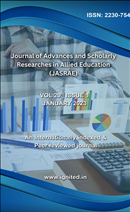Durability Performance of Self-Healing Concrete in Chloride-Induced Corrosion Environments
Keywords:
Durability, Chloride incursions, Electron probe microanalysis, Chloride profiles, Macro-encapsulated polyurethane, Corrosion behaviorAbstract
The use of self-healing concrete reduces the need for costly maintenance and repairs. However, research on the durability of self-healing concrete remains limited. The latest research demonstrates the ability of self-healing concrete to withstand chloride incursions. Electron probe microanalysis and chloride profiles demonstrated the effectiveness of the technique in self-healing concrete with macro-encapsulated polyurethane, reducing chloride penetration into cracks and from the fracture into the concrete matrix. Additionally, we investigated the corrosion behavior of specimens of reinforced concrete when exposed to a NaCl solution on a cyclic basis. Autonomous crack healing has the potential to drastically lower corrosion during the propagation stage, according to the electrochemical studies. The rebars showed no visible damage after 44 weeks of exposure. Conversely,fractured samples lacking an integrated self-healing mechanism had active corrosion after ten weeks of exposure, and after twenty-six weeks, rebars showed obvious pitting damage. Bacteria-based treatments require several weeks to cure a 300 µm fissure, but encapsulated polyurethane allows for self-healing in an hour. During the crack healing process, bacterial granules containing denitrifying cultures produced nitrite, an intermediate metabolic product, which shielded the reinforcement.
Downloads
References
Almusallam, T. H., Khan, F. A., Al-Amoudi, O. S., & Al-Salloum, Y. A. (2020). Advanced surface treatments for corrosion protection in reinforced concrete structures. Construction and Building Materials, 261, 120267.
Angst, U. M., Elsener, B., Larsen, C. K., & Vennesland, Ø. (2016). Critical chloride content in reinforced concrete—A review. Cement and Concrete Research, 88, 67-75.
Chen, L., Jin, X., & Sun, W. (2021). Self-healing materials for corrosion protection in reinforced concrete: A review. Construction and Building Materials, 299, 123842.
El-Reedy, M. A. (2020). Corrosion control in reinforced concrete structures: A review. Engineering Structures, 203, 109808.
Garcia, D., Torres, J., Rodríguez, J., & Andrade, C. (2021). Eco-friendly corrosion inhibitors for reinforced concrete: A review. Construction and Building Materials, 301, 124114.
Gouda, G., & Gupta, A. (2019). Corrosion inhibitors for reinforced concrete structures: A comprehensive review. Journal of Structural Integrity and Maintenance, 4(1), 41-53.
Hossain, K. M. A., & Thomas, M. D. A. (2018). Corrosion protection of steel reinforcement in concrete using galvanic anodes: A review. Construction and Building Materials, 166, 576-589.
Jones, A., & Patel, S. (2019). Novel hybrid coatings for corrosion protection in reinforced concrete structures. Journal of Materials Science, 54(15), 11534-11549.
Kim, J. H., & Ko, J. H. (2017). Epoxy coatings for corrosion protection in reinforced concrete: A review. Journal of Coatings Technology and Research, 14(2), 239-251.
Li, X., Wang, Q., & Ma, L. (2021). Comparative study on the corrosion resistance of epoxy-coated reinforcement bars in marine environments: A review. Journal of Marine Science and Engineering, 9(2), 125.
Liu, X., Song, Y., & Xi, W. (2017). Corrosion inhibitors for reinforced concrete: An overview. Journal of Materials in Civil Engineering, 29(7), 04017045.
Montemor, M. F. (2018). Chloride-induced corrosion on steel reinforcement: From the fundamentals to the monitoring techniques. Cement and Concrete Research, 113, 68-82.
Rahimi, M., Rahimi, M., & Razak, R. A. (2020). Galvanization of reinforcement bars for corrosion protection: A comprehensive review. Journal of Constructional Steel Research, 174, 106212.
Saha, A. K., Bandyopadhyay, N. R., & De, S. (2018). Effectiveness of galvanized reinforcement in resisting corrosion in concrete: A review. Journal of Materials in Civil Engineering, 30(3), 04018001.
Singh, S. K., & Bhattacharjee, B. (2019). Corrosion protection of steel in concrete using inhibitors: A review. Journal of Corrosion Science and Engineering, 22, 1-15.
Smith, J., Johnson, K., & Brown, L. (2018). Corrosion mechanisms and mitigation strategies in reinforced concrete structures: A comprehensive review. Construction and Building Materials, 190, 769-781.
Wang, L., & Li, C. (2020). Nano-coatings for enhanced corrosion protection in reinforced concrete: A review. Journal of Nanomaterials, 2020, 3150281.
Wang, X., Li, W., & Wang, C. (2019). Challenges and solutions in surface treatments for corrosion protection in reinforced concrete structures: A review. Journal of Coatings Technology and Research, 16(2), 413-429.
Xu, J., Sun, H., & Zhang, Y. (2020). Recent advancements in corrosion protection of reinforced concrete structures: A review. Journal of Building Engineering, 31, 101477.
Yildirim, G., & Lin, F. (2021). Sustainable corrosion protection methods for reinforced concrete structures: A review. Journal of Sustainable Materials and Technologies, 30, 100517.











